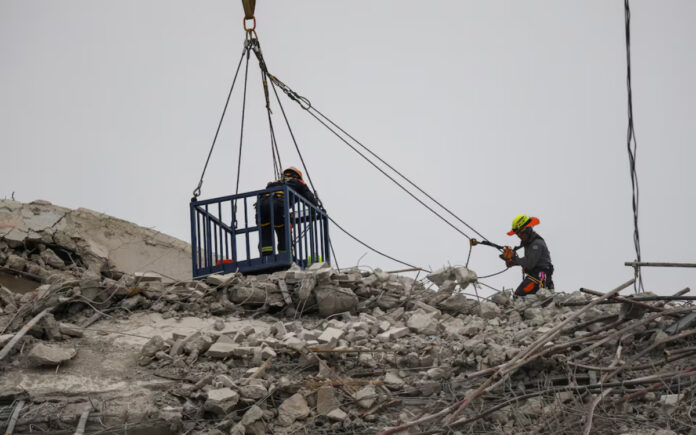Naypyidaw: The death toll from Myanmar’s devastating earthquake has climbed to 1,700, with rescue teams scrambling to provide aid to affected communities as hospitals struggle to cope with the influx of casualties. The 7.7-magnitude quake, one of the strongest to hit the Southeast Asian nation in a century, struck on Friday, leaving 3,400 injured and over 300 missing, according to the country’s military government.
Senior General Min Aung Hlaing, the junta chief, warned that the number of fatalities could rise further, acknowledging the scale of the challenge his administration faces. Three days after making a rare appeal for international assistance, state media reported that relief efforts from neighboring countries, including India, China, and Thailand, had begun arriving, along with aid teams from Malaysia, Singapore, and Russia.
The death toll from a 7.7-magnitude quake in Myanmar, one of the country's strongest in a century, has touched 1,700 https://t.co/ddAvxwzTSm pic.twitter.com/z3jHKZoseO
— Reuters (@Reuters) March 30, 2025
Mounting Humanitarian Crisis
The International Federation of Red Cross and Red Crescent Societies described the destruction as “extensive,” emphasizing that humanitarian needs are escalating rapidly.
“With temperatures rising and the monsoon season approaching in just weeks, there is an urgent need to stabilize affected communities before secondary crises emerge,” the organization stated.
The United States has pledged $2 million in aid, to be distributed through Myanmar-based humanitarian organizations. In a statement, Washington also confirmed that an emergency response team from USAID is being deployed to assist with relief efforts, despite funding cuts to the agency.
The quake’s devastation has further exacerbated Myanmar’s ongoing crisis, as the country remains embroiled in a civil conflict triggered by the military’s 2021 coup, which ousted the elected government of Nobel laureate Aung San Suu Kyi. The economic toll has been severe, with critical infrastructure—including bridges, highways, airports, and railways—suffering extensive damage, slowing rescue operations. The prolonged conflict has already displaced over 3.5 million people and crippled the healthcare system.
In quake-hit areas near the epicenter, residents described a dire lack of government assistance, leaving many to fend for themselves.
Desperate Search for Survivors
State media quoted Min Aung Hlaing as saying, “It is necessary to restore the transportation routes as soon as possible. It is necessary to fix the railways and also reopen the airports so that rescue operations would be more effective.”
The U.S. Geological Survey’s predictive modeling suggests that the final death toll could surpass 10,000, with economic losses potentially exceeding Myanmar’s annual output.
Hospitals in central and northwestern Myanmar, including those in the major cities of Mandalay and Naypyitaw, are struggling under the weight of injured victims, the United Nations Office for the Coordination of Humanitarian Affairs (OCHA) reported. The crisis has also spilled into neighboring Thailand, where tremors from the quake brought down an under-construction skyscraper in Bangkok, killing 18 people and trapping at least 76 beneath the rubble. Rescue workers in the Thai capital are using drones and sniffer dogs to locate survivors.
Myanmar’s opposition National Unity Government (NUG), which includes remnants of the previous administration, announced that anti-junta militias under its command would suspend offensive military actions for two weeks to allow relief efforts to proceed.
Communities Cut Off, Aid Struggles to Arrive
In Sagaing, near the quake’s epicenter, resident Han Zin described the devastation.
“What we are seeing here is widespread destruction—many buildings have collapsed into the ground,” he said via phone, adding that electricity has been cut off since the disaster struck, and drinking water supplies are running low.
“We have received no aid, and there are no rescue workers in sight.”
Satellite imagery confirmed that sections of a major bridge connecting Sagaing to nearby Mandalay had collapsed, with parts of the colonial-era structure submerged in the Irrawaddy River. The Sagaing Federal Unit Hluttaw, a political association linked to the NUG, noted on Facebook that relief efforts from Mandalay were facing significant delays due to the bridge’s destruction.
“Food and medicine are unavailable, and the rising number of casualties is overwhelming the small local hospital, which lacks the capacity to treat all the patients,” the group reported.
Also Read | Netanyahu: Hamas Must Disarm and Leave Gaza for Ceasefire Deal
Race Against Time in Mandalay and Bangkok
In Mandalay, where scores remain trapped under collapsed buildings, humanitarian workers reported using only basic tools to search for survivors.
“My teams in Mandalay are using work gloves, ropes, and basic kits to dig and retrieve people,” one aid worker told Reuters. “There are countless trapped and still missing. The death toll is impossible to count at the moment due to the number trapped and unidentified, if alive.”
Footage from a Mandalay resident showed patients lying on beds outside a 500-bed orthopedic hospital, some receiving intravenous drips in the open air. The World Health Organization confirmed that public and private healthcare facilities, including Mandalay General Hospital and parts of Mandalay Medical University, suffered damage from the quake.
Russian and Indian rescue workers are en route to Mandalay, while Chinese, Thai, and Singaporean teams have already arrived to assist.
Meanwhile, in Bangkok, rescue teams continue efforts to free workers trapped under the collapsed 33-story building. Thai police commander Teerasak Thongmo said emergency crews are racing against time.
“Right now, our team is trying to find anyone that might still be alive. Within the first 72 hours, we have to try and save those still alive,” he stated.
Near the disaster site, anguished family members of trapped workers waited anxiously for updates. One woman, overcome with emotion, repeatedly called out for her daughter.
“Ploy, Ploy, Ploy, my daughter, I’m here for you now!” she cried, as others embraced her. “Ploy, can you hear me calling out for you?”



